A top 2% investor warns we’re nearing the end of a ‘major financial euphoria episode’ reminiscent of the dot-com bubble

A trader in the Nasdaq 100 stock index futures pit at the Chicago Mercantile Exchange watches prices for electronic dealings in the contract November 22, 2000.
Bill Smead has only seen this once before during his 44-year career.
Investor exuberance about revolutionary technology, extremely lofty expectations, a penchant for risk-taking on highly volatile assets: For this generation of investors, this particularly strong cocktail of animal spirits that has driven the S&P 500’s 157% rally since March 2020 can only be compared to the dot-com bubble era leading up to 2000, Smead said in a December 10 note.
Smead is a highly successful long-term value investor, with his Smead Value Fund (SMVLX) beating 98% of similar funds over the last 15-year period, according to Morningstar data. He has a knack for finding stocks that trade at a discount, and constantly warns investors about the dangers that passive indexes can pose at times when valuations are high and investors are excessively greedy.
Now is one of those times, Smead thinks.
“This is the second time in my career (the first time for us at Smead Capital Management) that we find ourselves in the late stages of a major financial euphoria episode,” he said.
In his note, he laid out a few arguments for why we’re in a comparable spot to the 2000 peak.
Equity ownership as a percentage of household assets is at all-time highs. This may be partly due to investors chasing attractive returns in the market. But it can also be a signal that stock-market appreciation is simply outpacing gains in other asset classes, like real-estate, perhaps at an unsustainable pace.

Second, investors continue to bet on the “most aggressive” stocks in the Nasdaq Composite, he said. Volatile stocks like Tesla and Nvidia are up 73% and 177%, respectively, this year. Other speculative investments like bitcoin have been roaring, Smead pointed out. While it has dipped in recent days, the cryptocurrency is up 119% in 2024.
Investor sentiment can be a contrarian indicator of forward performance. Heightened interest in uber-risky assets can signal that investors are allowing greed, instead of fundamentals, to guide their decisions. Eventually, asset prices relative to earnings can simply become too expensive for buyers.
And third: “Many of the most respected investors of the last forty years are sounding alarms that are falling on deaf ears.” Among those warning of expensive valuations are GMO cofounder Jeremy Grantham and Research Affiliates founder Rob Arnott.
Since Smead published his note a couple of weeks back, the market has started to show signs of unraveling. The Dow Jones Industrial Average went on a 10-day losing streak and fell nearly 6%. The S&P 500 sank more than 3% on Wednesday alone after the Federal Reserve communicated its dissipating appetite for rate cuts
While you can’t predict when a bubble will finally pop, Smead said on Wednesday that the market can suffer when expectations are as high as they are. “There was nowhere to hide today,” he said in an email. “Incredibly high valuations allow zero comfort.”
There’s no denying that valuations are high. Here’s the Shiller CAPE ratio — current levels rival the dot-com peak.

That doesn’t necessarily mean that the market has to unwind in the weeks or months ahead. In fact, a vast majority of top Wall Street strategists see the S&P 500 advancing in 2025, and that could very well happen if the economy hangs in and AI-adjacent firms continue to beat expectations.
Historically, however, valuation levels like this mean the market is due for a rough 10-year period. David Kostin, the chief US equity strategist at Goldman Sachs, said earlier this year that he expects the market to underperform risk-free 10-year Treasury yields on an annualized basis over the next decade.
But a large part of those losses can come all at once — and Smead warns that time could come soon.






